2007 MERCEDES-BENZ C-CLASS ESTATE service
[x] Cancel search: servicePage 49 of 377
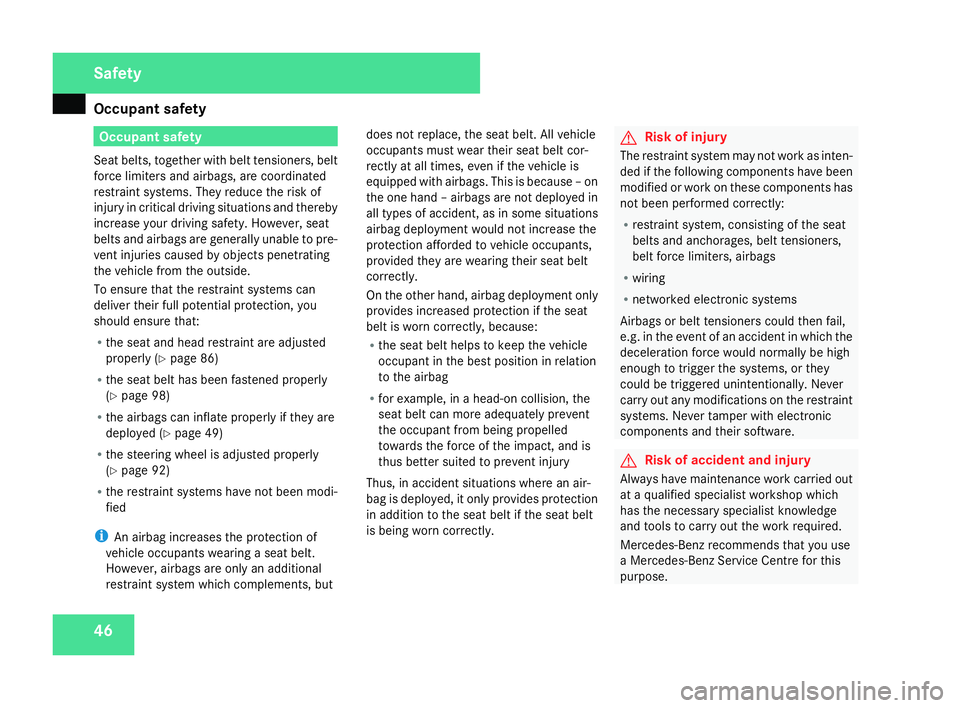
Occupant safet
y46 Occupant safet
y
Seat belts, together with belt tensioners, belt
force limiters and airbags, are coordinate d
restraint systems. They reduce the risk of
injury in critical driving situations and thereby
increase your driving safety. However, seat
belts and airbags are generally unable to pre-
vent injuries caused by objects penetrating
the vehicle from the outside.
To ensure that the restraint systems can
deliver their full potential protection, you
should ensure that:
R the seat and head restraint are adjusted
properly (Y page 86)
R the seat belt has been fastened properl y
( Y page 98)
R the airbags can inflate properly if they ar e
deployed (Y page 49)
R the steering wheel is adjusted properl y
( Y page 92)
R the restraint systems have not been modi-
fied
i An airbag increases the protection of
vehicle occupants wearing a seat belt.
However, airbags are only an additional
restraint system which complements, bu tdoes not replace, the seat belt. All vehicle
occupants must wear their seat belt cor-
rectly at all times, even if the vehicle is
equipped with airbags. This is because – on
the one hand – airbags are not deployed in
all types of accident, as in some situation
s
airbag deployment would not increase th e
protection afforded to vehicle occupants,
provided they are wearing their seat belt
correctly.
On the other hand, airbag deployment only
provides increased protection if the seat
belt is worn correctly, because:
R the seat belt helps to keep the vehicl e
occupant in the best position in relation
to the airbag
R for example, in a head-on collision, the
seat belt can more adequately prevent
the occupant from being propelle d
towards the force of the impact, and is
thus better suited to prevent injury
Thus, in accident situations where an air-
bag is deployed, it only provides protection
in addition to the seat belt if the seat belt
is being worn correctly. G
Risk of injury
The restraint system may not work as inten-
ded if the following components have bee n
modified or work on these components has
not been performed correctly:
R restraint system, consisting of the seat
belts and anchorages, belt tensioners,
belt force limiters, airbags
R wirin g
R networked electronic system s
Airbags or belt tensioners could then fail ,
e.g. in the event of an accident in which the
deceleration force would normally be high
enough to trigger the systems, or they
could be triggered unintentionally. Never
carry out any modifications on the restraint
systems. Never tamper with electronic
components and their software. G
Risk of accident and injury
Always have maintenance work carried ou t
at a qualified specialist workshop whic h
has the necessary specialist knowledge
and tools to carry out the work required.
Mercedes-Benz recommends that you use
a Mercedes-Benz Service Centre for this
purpose. Safety
204_AKB; 2; 3, en-GB
mkalafa,
2007-06-26T23:11:51+02:00 - Seite 46
Page 52 of 377
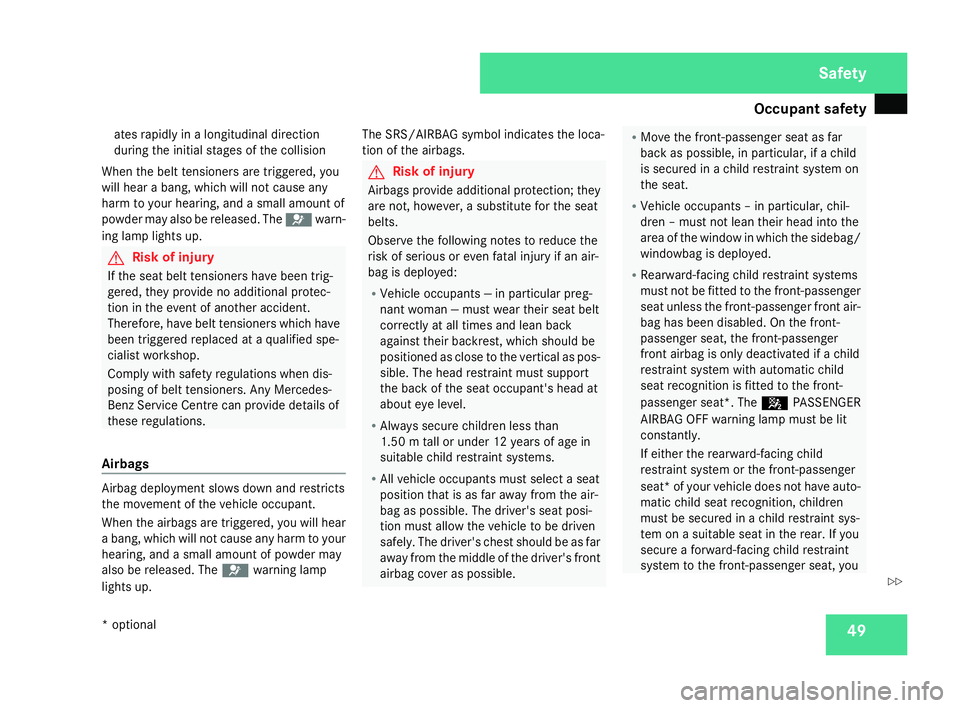
Occupant safet
y 49
ates rapidly in a longitudinal direction
during the initial stages of the collision
When the belt tensioners are triggered, you
will hear a bang, which will not cause any
harm to your hearing, and a small amount of
powder may also be released. The =warn-
ing lamp lights up. G
Risk of injury
If the seat belt tensioners have been trig -
gered, they provide no additional protec -
tion in the event of another accident.
Therefore, have belt tensioners which have
been triggered replaced at a qualified spe-
cialist workshop .
Comply with safety regulations when dis-
posing of belt tensioners. Any Mercedes-
Benz Service Centre can provide details of
these regulations.
Airbag s Airbag deployment slows down and restricts
the movement of the vehicle occupant.
When the airbags are triggered, you will hear
a bang, which will not cause any harm to your
hearing, and a small amount of powder ma y
also be released. The =warning lamp
lights up. The SRS/AIRBAG symbol indicates the loca-
tion of the airbags
. G
Risk of injury
Airbags provide additional protection; they
are not, however, a substitute for the sea t
belts.
Observe the following notes to reduce the
risk of serious or even fatal injury if an air-
bag is deployed:
R Vehicle occupants — in particular preg-
nant woman — must wear their seat belt
correctly at all times and lean back
against their backrest, which should be
positioned as close to the vertical as pos-
sible. The head restraint must support
the back of the seat occupant's head at
about eye level.
R Always secure children less tha n
1.50 mtall or under 12 years of age in
suitable child restraint systems.
R All vehicle occupants must select a sea t
position that is as far away from the air-
bag as possible. The driver's seat posi-
tion must allow the vehicle to be driven
safely. The driver's chest should be as far
away from the middle of the driver's fron t
airbag cover as possible. R
Move the front-passenger seat as far
back as possible, in particular, if a child
is secured in a child restraint system on
the seat.
R Vehicle occupants – in particular, chil-
dren – must not lean their head into the
area of the window in which the sidebag/
windowbag is deployed.
R Rearward-facing child restraint systems
must not be fitted to the front-passenger
seat unless the front-passenger front air-
bag has been disabled. On the front-
passenger seat, the front-passenger
front airbag is only deactivated if a child
restraint system with automatic child
seat recognition is fitted to the front-
passenger seat *.The 5 PASSENGER
AIRBAG OFF warning lamp must be li t
constantly .
If either the rearward-facing child
restraint system or the front-passenger
seat* of your vehicle does not have auto-
matic child seat recognition, childre n
must be secured in a child restraint sys-
tem on a suitable seat in the rear. If you
secure a forward-facing child restraint
system to the front-passenger seat, you Safety
* optiona l
204_AKB; 2; 3, en-GB
mkalafa,
2007-06-26T23:11:51+02:00 - Seite 49 Z
Page 54 of 377
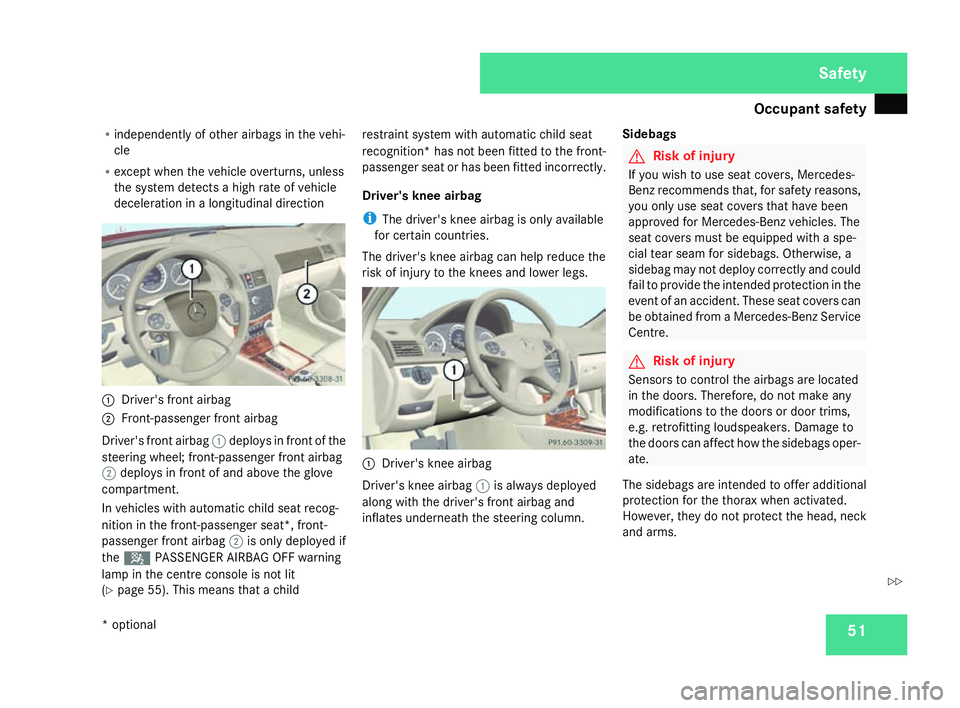
Occupant safet
y 51
R
independently of other airbags in the vehi-
cle
R except when the vehicle overturns, unless
the system detects a high rate of vehicle
deceleration in a longitudinal direction 1
Driver's front airba g
2 Front-passenger front airba g
Driver's front airbag 1deploys in front of the
steering wheel; front-passenger front airbag
2 deploys in front of and above the glove
compartment .
In vehicles with automatic child seat recog-
nition in the front-passenger seat*, front-
passenger front airbag 2is only deployed if
the 5 PASSENGER AIRBAG OFF warning
lamp in the centre console is not lit
( Y page 55). This means that a child restraint system with automatic child seat
recognition* has not been fitted to the front-
passenger seat or has been fitted incorrectly.
Driver's knee airba
g
i The driver's knee airbag is only available
for certain countries.
The driver's knee airbag can help reduce the
risk of injury to the knees and lower legs. 1
Driver's knee airba g
Driver's knee airbag 1is always deployed
along with the driver's front airbag and
inflates underneath the steering column. Sidebags G
Risk of injury
If you wish to use seat covers, Mercedes-
Benz recommends that, for safety reasons ,
you only use seat covers that have been
approved for Mercedes-Benz vehicles. The
seat covers must be equipped with a spe -
cial tear seam for sidebags. Otherwise, a
sidebag may not deploy correctly and could
fail to provide the intended protection in the
event of an accident. These seat covers can
be obtained from a Mercedes-Benz Service
Centre. G
Risk of injury
Sensors to control the airbags are locate d
in the doors. Therefore, do not make any
modifications to the doors or door trims,
e.g. retrofitting loudspeakers. Damage to
the doors can affect how the sidebags oper-
ate.
The sidebags are intended to offer additional
protection for the thorax when activated.
However, they do not protect the head, nec k
and arms. Safety
* optional
204_AKB; 2; 3, en-GB
mkalafa
, 2007-06-26T23:11:51+02:00 - Seite 51 Z
Page 56 of 377
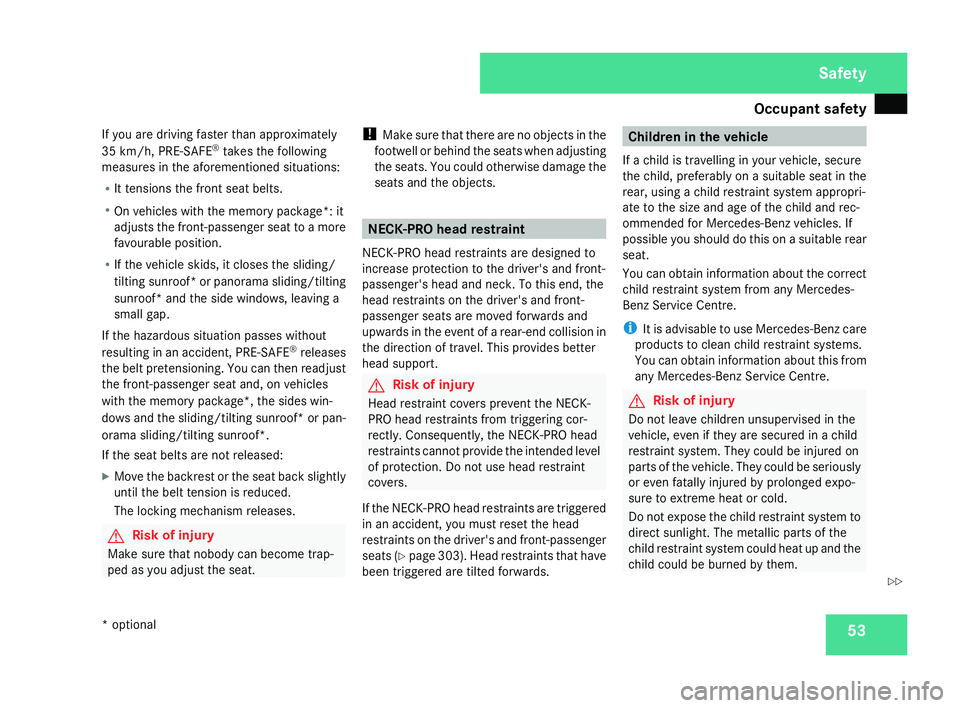
Occupant safet
y 53
If you are driving faster than approximately
35 km/h, PRE-SAFE ®
takes the following
measures in the aforementioned situations:
R It tensions the front seat belts.
R On vehicles with the memory package*: it
adjusts the front-passenger seat to a more
favourable position.
R If the vehicle skids, it closes the sliding/
tilting sunroof* or panorama sliding/tilting
sunroof* and the side windows, leaving a
small gap.
If the hazardous situation passes without
resulting in an accident, PRE-SAFE ®
releases
the belt pretensioning. You can then readjust
the front-passenger seat and, on vehicles
with the memory package*, the sides win-
dows and the sliding/tilting sunroof* or pan-
orama sliding/tilting sunroof* .
If the seat belts are not released:
X Move the backrest or the seat back slightly
until the belt tension is reduced.
The locking mechanism releases. G
Risk of injury
Make sure that nobody can become trap -
ped as you adjust the seat. !
Make sure that there are no objects in the
footwell or behind the seats when adjustin g
the seats. You could otherwise damage the
seats and the objects . NECK-PRO head restrain
t
NECK-PRO head restraints are designed to
increase protection to the driver's and front-
passenger's head and neck. To this end, the
head restraints on the driver's and front-
passenger seats are moved forwards and
upwards in the event of a rear-end collision in
the direction of travel. This provides better
head support. G
Risk of injury
Head restraint covers prevent the NECK -
PRO head restraints from triggering cor-
rectly. Consequently, the NECK-PRO head
restraints cannot provide the intended level
of protection. Do not use head restraint
covers .
If the NECK-PRO head restraints are triggered
in an accident, you must reset the head
restraints on the driver's and front-passenger
seats (Y page 303). Head restraints that have
been triggered are tilted forwards. Children in the vehicle
If a child is travelling in your vehicle, secure
the child, preferably on a suitable seat in the
rear, using a child restraint system appropri-
ate to the size and age of the child and rec-
ommended for Mercedes-Benz vehicles. If
possible you should do this on a suitable rear
seat.
You can obtain information about the correct
child restraint system from any Mercedes-
Benz Service Centre.
i It is advisable to use Mercedes-Benz care
products to clean child restraint systems.
You can obtain information about this from
any Mercedes-Benz Service Centre. G
Risk of injury
Do not leave children unsupervised in the
vehicle, even if they are secured in a chil d
restraint system. They could be injured on
parts of the vehicle. They could be seriously
or even fatally injured by prolonged expo-
sure to extreme heat or cold.
Do not expose the child restraint system to
direct sunlight. The metallic parts of the
child restraint system could heat up and the
child could be burned by them. Safety
* optional
204_AKB; 2; 3, en-GB
mkalafa,
2007-06-26T23:11:51+02:00 - Seite 53 Z
Page 58 of 377
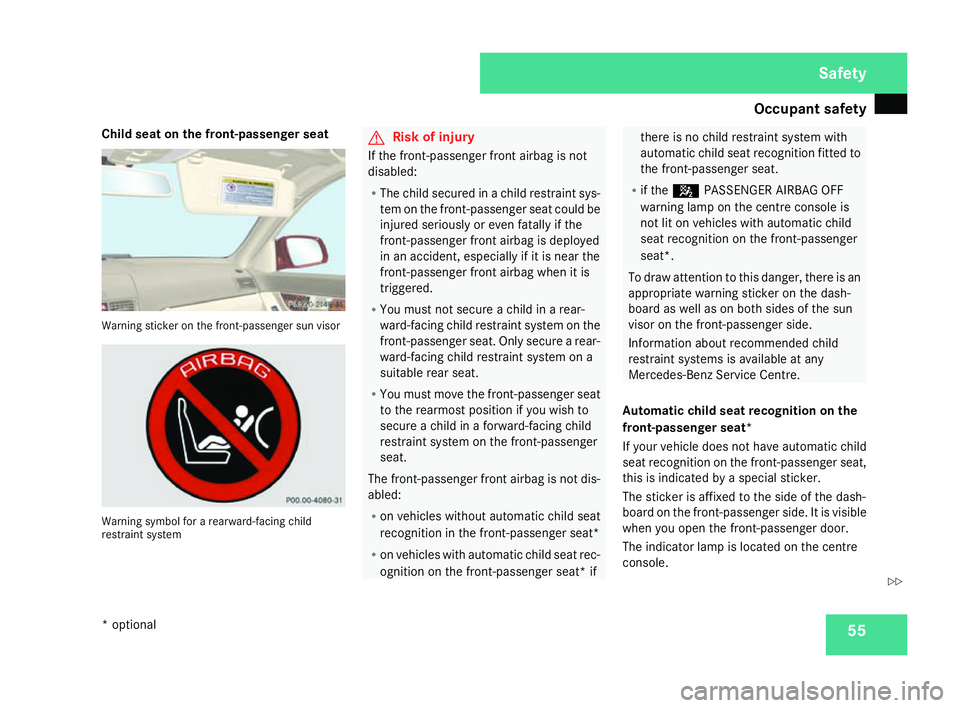
Occupant safet
y 55
Child seat on the front-passenger seat
Warning sticker on the front-passenger sun visor
Warning symbol for a rearward-facing child
restraint system G
Risk of injury
If the front-passenger front airbag is not
disabled:
R The child secured in a child restraint sys-
tem on the front-passenger seat could be
injured seriously or even fatally if the
front-passenger front airbag is deployed
in an accident, especially if it is near the
front-passenger front airbag when it is
triggered.
R You must not secure a child in a rear-
ward-facing child restraint system on the
front-passenger seat. Only secure a rear-
ward-facing child restraint system on a
suitable rear seat.
R You must move the front-passenger seat
to the rearmost position if you wish to
secure a child in a forward-facing child
restraint system on the front-passenge r
seat.
The front-passenger front airbag is not dis-
abled:
R on vehicles without automatic child seat
recognition in the front-passenger seat*
R on vehicles with automatic child seat rec-
ognition on the front-passenger seat* if there is no child restraint system with
automatic child seat recognition fitted to
the front-passenger seat.
R if the 5 PASSENGER AIRBAG OFF
warning lamp on the centre console is
not lit on vehicles with automatic child
seat recognition on the front-passenger
seat*.
To draw attention to this danger, there is an
appropriate warning sticker on the dash-
board as well as on both sides of the sun
visor on the front-passenger side.
Information about recommended child
restraint systems is available at any
Mercedes-Benz Service Centre.
Automatic child seat recognition on the
front-passenger seat*
If your vehicle does not have automatic child
seat recognition on the front-passenger seat,
this is indicated by a special sticker.
The sticker is affixed to the side of the dash-
board on the front-passenger side. It is visible
when you open the front-passenger door.
The indicator lamp is located on the centre
console. Safety
* optional
204_AKB; 2; 3, en-GB
mkalafa,
2007-06-26T23:11:51+02:00 - Seite 55 Z
Page 67 of 377
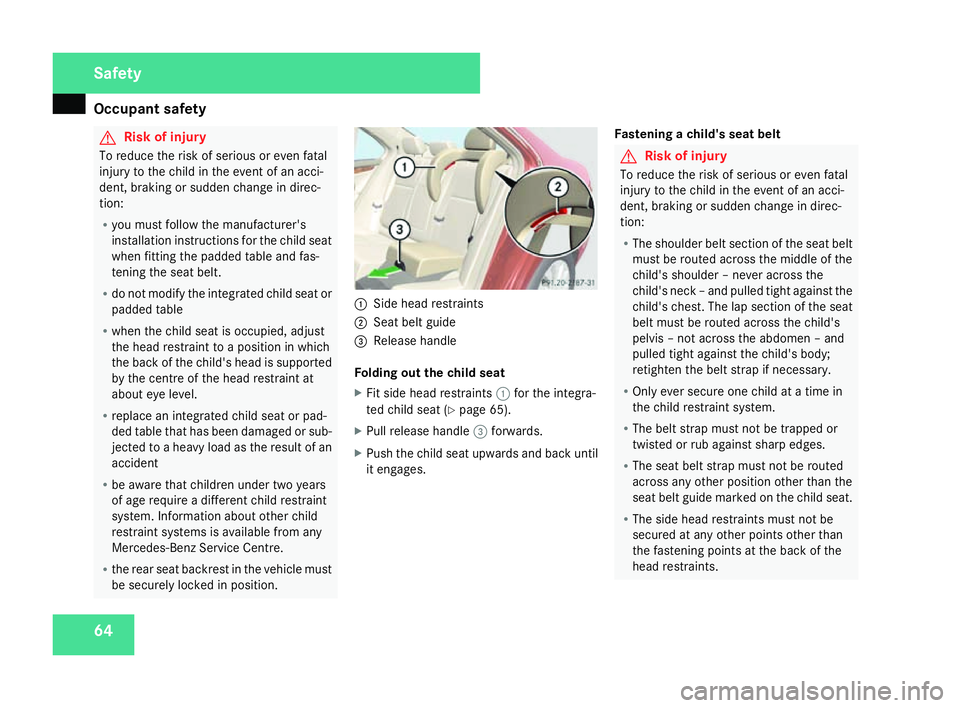
Occupant safet
y64 G
Risk of injury
To reduce the risk of serious or even fata l
injury to the child in the event of an acci-
dent, braking or sudden change in direc -
tion:
R you must follow the manufacturer' s
installation instructions for the child seat
when fitting the padded table and fas-
tening the seat belt.
R do not modify the integrated child seat or
padded table
R when the child seat is occupied, adjus t
the head restraint to a position in which
the back of the child's head is supporte d
by the centre of the head restraint at
about eye level.
R replace an integrated child seat or pad-
ded table that has been damaged or sub-
jected to a heavy load as the result of an
acciden t
R be aware that children under two years
of age require a different child restraint
system. Information about other child
restraint systems is available from any
Mercedes-Benz Service Centre.
R the rear seat backrest in the vehicle must
be securely locked in position. 1
Side head restraints
2 Seat belt guid e
3 Release handle
Folding out the child sea t
X Fit side head restraints 1for the integra -
ted child seat (Y page 65).
X Pull release handle 3forwards.
X Push the child seat upwards and back until
it engages. Fastening a child's seat belt G
Risk of injury
To reduce the risk of serious or even fata l
injury to the child in the event of an acci-
dent, braking or sudden change in direc -
tion:
R The shoulder belt section of the seat belt
must be routed across the middle of the
child's shoulder – never across the
child's neck – and pulled tight against the
child's chest. The lap section of the seat
belt must be routed across the child's
pelvis – not across the abdomen – and
pulled tight against the child's body;
retighten the belt strap if necessary.
R Only ever secure one child at a time in
the child restraint system.
R The belt strap must not be trapped or
twisted or rub against sharp edges.
R The seat belt strap must not be routed
across any other position other than the
seat belt guide marked on the child seat.
R The side head restraints must not be
secured at any other points other than
the fastening points at the back of the
head restraints. Safety
204_AKB; 2; 3, en-GB
mkalafa,
2007-06-26T23:11:51+02:00 - Seite 64
Page 68 of 377
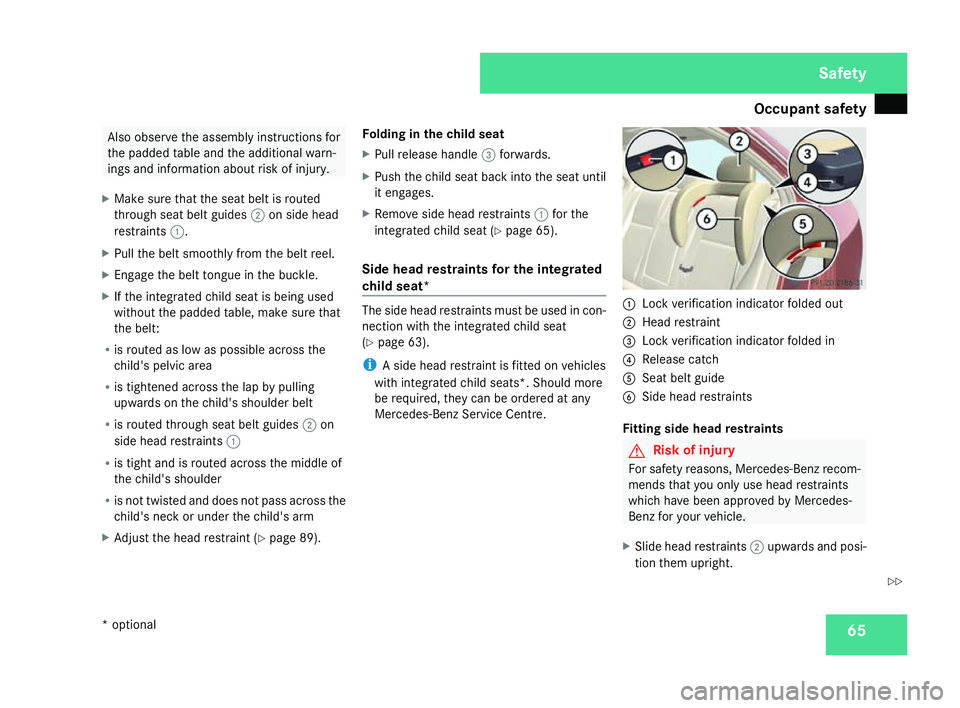
Occupant safet
y 65Also observe the assembly instructions for
the padded table and the additional warn-
ings and information about risk of injury.
X Make sure that the seat belt is routed
through seat belt guides 2on side head
restraints 1.
X Pull the belt smoothly from the belt reel.
X Engage the belt tongue in the buckle .
X If the integrated child seat is being used
without the padded table, make sure that
the belt:
R is routed as low as possible across the
child's pelvic area
R is tightened across the lap by pulling
upwards on the child's shoulder belt
R is routed through seat belt guides 2on
side head restraints 1
R is tight and is routed across the middle of
the child's shoulder
R is not twisted and does not pass across the
child's neck or under the child's arm
X Adjust the head restraint (Y page 89). Folding in the child seat
X
Pull release handle 3forwards.
X Push the child seat back into the seat until
it engages.
X Remove side head restraints 1for the
integrated child seat (Y page 65).
Side head restraints for the integrated
child seat* The side head restraints must be used in con
-
nection with the integrated child sea t
( Y page 63).
i A side head restraint is fitted on vehicles
with integrated child seats*. Should mor e
be required, they can be ordered at any
Mercedes-Benz Service Centre. 1
Lock verification indicator folded out
2 Head restraint
3 Lock verification indicator folded in
4 Release catch
5 Seat belt guid e
6 Side head restraints
Fitting side head restraints G
Risk of injury
For safety reasons, Mercedes-Benz recom-
mends that you only use head restraints
which have been approved by Mercedes-
Benz for your vehicle.
X Slide head restraints 2upwards and posi -
tion them upright. Safety
* optional
204_AKB; 2; 3, en-G
B
mkalafa , 2007-06-26T23:11:51+02:00 - Seite 65 Z
Page 102 of 377
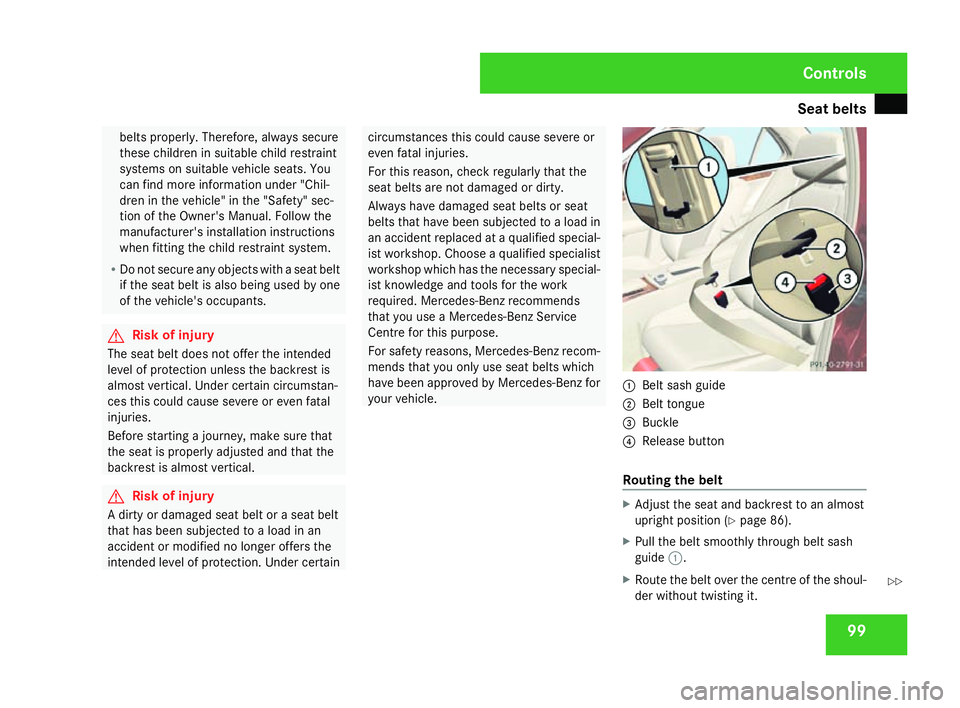
Seat belts
99belts properly. Therefore, always secure
these children in suitable child restraint
systems on suitable vehicle seats. You
can find more information under "Chil-
dren in the vehicle" in the "Safety" sec-
tion of the Owner's Manual. Follow the
manufacturer's installation instructions
when fitting the child restraint system .
R Do not secure any objects with a seat belt
if the seat belt is also being used by one
of the vehicle's occupants. G
Risk of injury
The seat belt does not offer the intended
level of protection unless the backrest is
almost vertical. Under certain circumstan-
ces this could cause severe or even fata l
injuries.
Before starting a journey, make sure that
the seat is properly adjusted and that the
backrest is almost vertical. G
Risk of injury
A dirty or damaged seat belt or a seat bel t
that has been subjected to a load in an
accident or modified no longer offers the
intended level of protection. Under certai n circumstances this could cause severe or
even fatal injuries.
For this reason, check regularly that the
seat belts are not damaged or dirty.
Always have damaged seat belts or sea t
belts that have been subjected to a load in
an accident replaced at a qualified special-
ist workshop. Choose a qualified specialist
workshop which has the necessary special-
ist knowledge and tools for the work
required. Mercedes-Benz recommends
that you use a Mercedes-Benz Service
Centre for this purpose.
For safety reasons, Mercedes-Benz recom -
mends that you only use seat belts which
have been approved by Mercedes-Benz for
your vehicle. 1
Belt sash guid e
2 Belt tongu e
3 Buckl e
4 Release butto n
Routing the belt X
Adjust the seat and backrest to an almos t
upright position (Y page 86).
X Pull the belt smoothly through belt sash
guide 1.
X Route the belt over the centre of the shoul-
der without twisting it . Cont
rols
204_AKB; 2; 3, en-GB
mkalafa,
2007-06-26T23:11:51+02:00 - Seite 99 Z